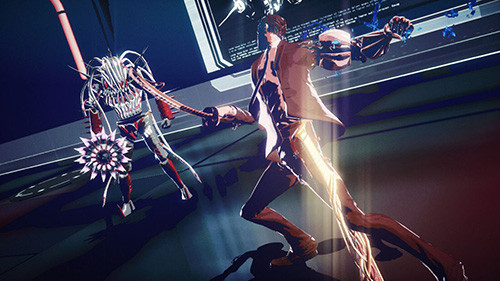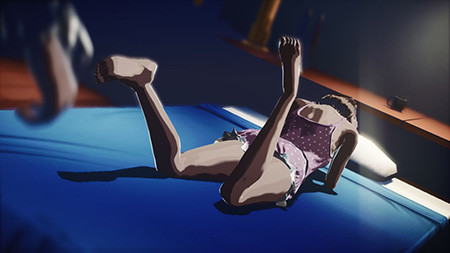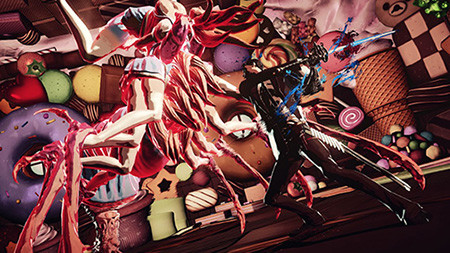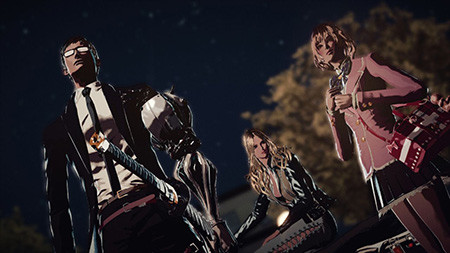Game Review
by Dave Riley,Killer is Dead
Xbox 360 / PS3
| Description: |  |
||
Mondo Zappa works for an agency specializing in executions funded by the state. Killer is Dead is the story of Mondo coming to grips with his mysterious past while performing executions on giant demons and evil trains. |
|||
| Review: | |||
What makes a Suda game a Suda game? His name is on just about everything Grasshopper Manufacture puts out, but his most recent director credit is for the excellent-but-microscopic Liberation Maiden. His last fully-fledged game? Fatal Frame IV, whose limp-wristed run animations and sheepish schoolgirl ghost gasps could've been made by anyone. The recent games that we think of as "Suda51," Lollipop Chainsaw, Shadows of the Damned, No More Heroes 2, credit him as either creative director or executive director, both fairly nebulous terms. Killer is Dead is directed by Hideyuki Shin, but Suda's influence is obvious. We'd know it was him even if he didn't have a writing credit. The game is stuffed with pop culture references, obtuse narrative, and fourth wall-breaking conversations. Mondo is a guy in a suit, last name Zappa, contracted by a lady named Moon River to bring down David (Gilmour?), who lives on the dark side of the moon. This is the Suda51 pure form. The snippet above is not plot of the game, it's the plot of level four. Like Killer 7 and No More Heroes, Killer is Dead is mostly episodic. Aloof, business-suited Mondo is the James Bond of the contract killing world, executing those who need to be executed and seducing those who need to be seduced. He does the former with a katana and a robot arm, the later with gifts of chewing gum and necklaces. Mondo works for an outfit with ties to "the state." His targets are demagogues and demonic trains, slotting in nicely with the antagonists of previous games, though none really reach the heights of battling a manga artist's sentai squad.
The sword and gun fighting (the gun is hidden in the robot arm) is primarily a one-button thing. Mondo has both a perfect dodge and a perfect guard, which he can use to set up button-mashing slash attacks or exploit enemies, leaving them, claws stuck in the ground, perfectly, and satisfyingly, vulnerable to attack. Both guns and slashes use Blood, a special meter recharged by melee attacks. Blood levels up, and so does Mondo's life bar, with trinkets scrounged from defeated foes. Higher combos lead to execution kills, where the player can select what sort of experience they'd like: life, or blood, or moon crystals, the last of which Mondo spends on upgrades to dodge, attack speed, charge moves, and guard breaks. This is about as good as Grasshopper gameplay gets, even counting the Shinji Mikami-backed Shadows of the Damned. It is not a Bayonetta, it is not anywhere close to that, but sword slashes are fast and fun, especially after a few speed upgrades, and Mondo can cancel into a dodge or block at any time, allowing him to maintain constant pressure and switch between enemies on a whim. The levels here are similar to those in No More Heroes, basically straight lines on the way to an absurd(-ly large, gross, or surreal) boss, but they are generally shorter and enemy health bars are substantially smaller. Killer is Dead moves at a better pace than most other Grasshopper outings and doesn't wear out its mechanics by requiring endless combos on damage sponges posing as generic thugs. Even so, technical niggles remain: the camera lodges itself wherever it feels like (usually in terrain) and the screen tearing is near-constant. Mondo gains more weapons from Gigolo missions, minigame-ized dating sims that would be creepy and offensive if they weren't so abrasive and lame. The way to romance a girl, according to Killer is Dead, is to stare at her privates until you've gathered up sufficient guts to shower her in gifts. Eventually, given enough presents, she'll decide you've met the purchase price, strip down, and hand over a freeze ray. It's like the lonely internet's sour grapes understanding of dating. "She didn't like me because I wasn't brave enough to buy sex with macarons and earrings."
Maybe its supposed to be awful, maybe it's on purpose. You almost have to think it is on purpose, because it would be too tragic to imagine the person who thought this was fun or, god forbid, erotic. But it isn't enough to say "it's a Suda game so it must be satire," because the intent of satire isn't sufficient, especially if you're creating something functionally identical to what you're satirizing. This holds for all the camera winking, too. When Mondo contradicts the level boss's because "that's not what players want from their action games" are we meant to applaud simply because we're being referenced? It feels like a band shouting out the name of a city at a concert. The beginning of Killer is Dead imbues heady expectations in its player. Talk of "the state" recalls Killer 7's evasive-but-compelling political narrative, but those threads are soon dropped and a personal narrative appears in their place. Suddenly it's about Mondo and his mysterious past (he has amnesia, natch). The story is told like it's skipping every third word, related through dream sequence-flashbacks that evoke El Shaddai but are not as effective as El Shaddai. This dream logic carries over to the main plot, where every scene takes place during the third act of a play without a first or a second. Mondo has a history. What history? We're never really told. You can piece it together from interviews on the internet, if you'd like, but examining the plot based solely on the text is not particularly satisfying. Killer is Dead is so bare that it's difficult to get any sense, meaning, or often even enjoyment from its narrative. That's a tough way to tell a story, even one with such ultimate confidence in its world and its characters, confidence that is apparent every time Mondo flicks his hair back and says "The job… Killer is Dead," even though we don't really know what that means (maybe nobody does). Confidence is good. Games should have more confidence, even if they're silly (especially if they're silly), and if Killer is Dead can be taken as silly then that makes is complete lack of cohesion easier to stomach.
But it doesn't seem silly. It seems like it takes itself pretty seriously. Or at least, say, 75% seriously. It wants to be noir: the dark and rainy alley of an early level tells us that much. The characters are drawn in shifting shadows, cel-shaded in a way that looks great even without a huge budget backing it up. The rain-swept tutorial, and an Alice in Wonderland house gone all topsy turvy, soon give way to unexciting boxes standing in for mansions or runaway trains. Much of the set design and composition is reminiscent of bare-bones Dreamcast games. All of the stages are reused as challenge levels when, really, they barely had enough detail for their first run. Bosses are, for the most part, big, or exciting, or interesting and always weird, but the cannon fodder are piles of metal gobbledegook of which there are really only six or seven distinct kinds, and they're all pretty stupid and easily dispatched. Momentum sustains the gameplay, not incisive critique, graphical proficiency, or battle tactics. Killer is Dead is too self-aware to take at face value, but not proficient enough to come across as effective satire. If it is trying to be serious it is yards behind Metal Gear Rising. If it is trying to be silly it is miles behind Bayonetta. Besides which, both of those games had A-grade gameplay backing their narratives. Killer is Dead is fast and frantic enough -- you are seconds away from the next shower of currency and crystals and blood, minutes away from the next tiger race or spider boss -- that you don't really notice many of the flaws until it's over. That's fine. That's an okay thing for a game to be, but there's something tired about it. It has all the trappings of a Grasshopper game, but it's missing the enthusiasm. The fourth wall antics and referential names don't seem to have any purpose but filling time. This game feels like a trinket, or a curio, or a seventh generation copy of the manuscript we're actually after.
Maybe the man who made Killer 7 no longer exists; there's precious little hint of him here, beyond the superficial. If that's the case then Killer is Dead, with its remarkably similar title font, unfairly trades on memories of a game that was also convoluted, but considerably more comprehensible and infinitely more original. There are times when this game laces together scenes that are dark, strange, and surreal -- these are the things we love about Suda games, the things they we don't see too often outside of Suda games -- but there are more times when it drowns you in references to pop culture, to the point where it feels like the guy in charge, Suda or Hideyuki Shin or whoever, is barking up the wrong tree, a tree filled with movie makers and musicians and game directors who he thinks are more popular, or more intelligent, or more whatever, and if he can just reference them enough then maybe he'll be popular, and intelligent, and whatever too. There's the exhausting Mika, a woefully archetypal (read: idiotic) genki girl as seen in every anime ever. She supposed to be Mondo's assistant, but really she's just there to throw her ass into his stomach when he runs out of health. There's Vivienne, the motorcycle riding hot chick, her tan jumpsuit unzipped, sure to show exactly as much bra and cleavage as Metal Gear Solid's Eva. There's Akira Yamaoka soundtrack that snatches bits of Dvorak, because that seems to be the hot thing to do, as seen in Catherine, Asura's Wrath, hell, even One Piece. There's Moon River, who looks like Audrey Hepburn in case you didn't get the reference. Killer is Dead is good when it is "Grasshopper," but more often it is "Grasshopper shows you all the stuff it really likes." The machinegun barrage of references is less like passion and more like slapdash pastiche, quips and quirks inserted to fill time. A watered-down Grasshopper game is probably better for games as a medium than a dozen God of Wars or a thousand otaku-bait dating sims, but so much of Killer is Dead feels like amalgam, feels like manufacture. Grasshopper's motto is "punk's not dead," but Killer is Dead forces the question "which parts are punk and which parts are pandering?" |
|
The views and opinions expressed in this article are solely those of the author(s) and do not necessarily represent the views of Anime News Network, its employees, owners, or sponsors.
|
| Grade: | |||
Overall : C+
Graphics : C+
Sound/Music : B-
Gameplay : C+
Presentation : C-
+ Combat is frenetic, the occasional silly story aside is charming |
|||
| discuss this in the forum (14 posts) | | |||



